The Buzzy A24 Film Making Trans and Queer Viewers Feel Seen
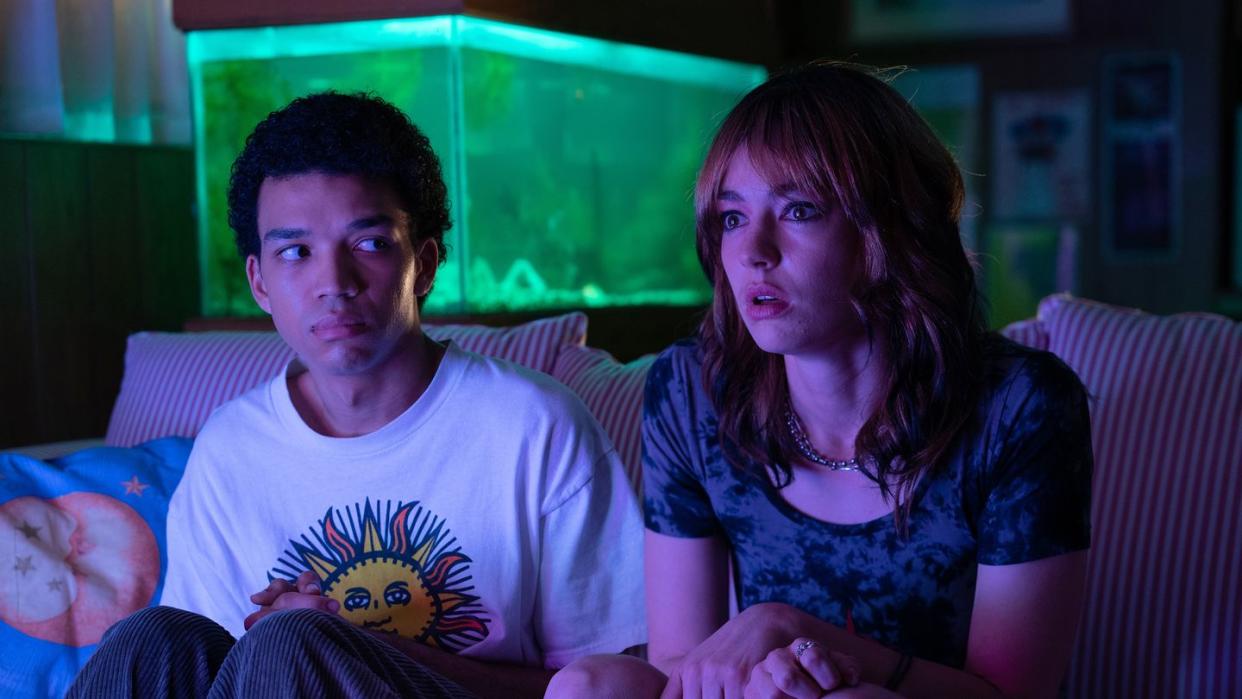
- Oops!Something went wrong.Please try again later.
- Oops!Something went wrong.Please try again later.
- Oops!Something went wrong.Please try again later.
Watching Jane Schoenbrun’s second feature, I Saw the TV Glow, is a theatrical experience unlike any other. The We’re All Going to the World’s Fair director follows the friendship between two teenagers in the ’90s, Maddy (Brigette Lundy-Paine) and Owen (Justice Smith), and their deep love of the Buffy The Vampire Slayer-meets-Are You Afraid of The Dark? faux television show, The Pink Opaque. But when their reality begins to blur with the show, they start to question their identity. After my first viewing, soaked in tears, I felt excavated inside-out. Subsequent viewings only added to that feeling, that I was seeing something that spoke so loudly and purposefully for me.
I’m not alone—a myriad of other people who also identify in the spectrum of the LGBTQ community have felt similarly upon seeing the film. It’s a sentiment that Schoenbrun, Lundy-Paine, and Smith have already been receiving before TV Glow’s May 3 release. “I’m getting this a lot and I’m definitely not just getting this from trans folks, a lot of queer folks, and people who had an emotional relationship with media in a formative time that was standing in or occupying a lot of their emotional space,” Schoenbrun says. “I think one of the biggest things you can try to do as an artist is elucidate experience that’s invisible like that, right? A large population is having that kind of extreme emotional reaction and another part of the population is like, ‘What are you talking about?’” They continue, “This is perhaps the thing that I’m proudest of, or that I am humbled to have happen, is that something that was previously invisible, or an experience that a lot of people have had that felt personal and unexplainable, becomes something that there is now common language to discuss.”
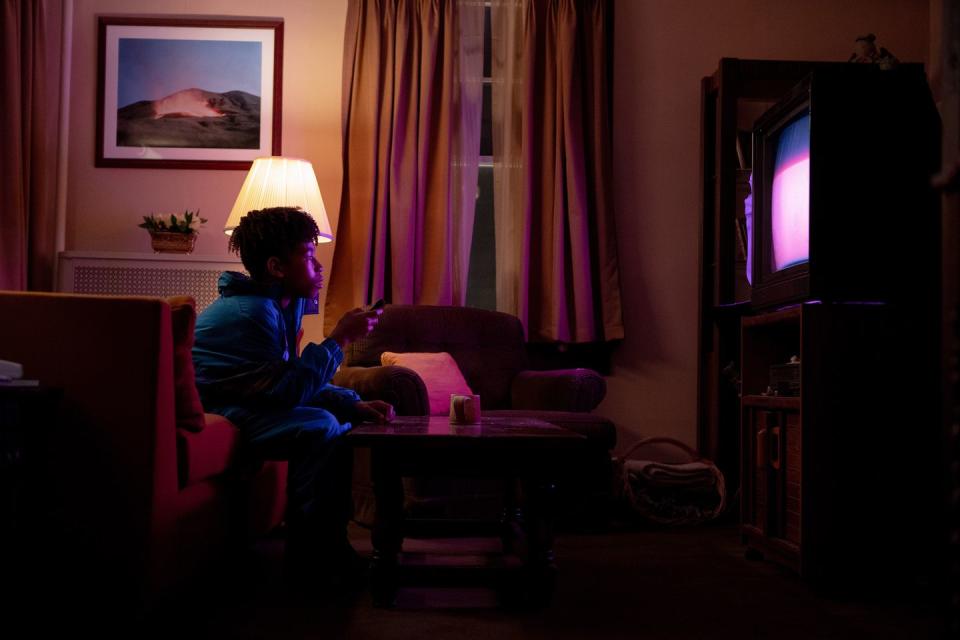
What has elicited such an emotional experience for so many first began as a mishmash of ideas that were long floating around in Schoenbrun’s head, even before their first feature, World’s Fair. “I can remember 10 years ago thinking about how to make art about the way it felt to watch television as a kid. I had an idea for a different movie about coming back to the suburbs and then I had an idea for a movie that would be this haunted version of the SNICK Saturday night programming block [on Nickelodeon].” But then they realized “these two seemingly unrelated ideas...merged into one idea.”
Growing up, there was probably a show or film that you loved fiercely and without question. For Schoenbrun, that was Buffy the Vampire Slayer. (The very carefully placed Buffy references in the film would excite even a casual fan.) Usually, this attachment is also a way to cope—or not cope—with external forces happening to you as a teenager, however that looks like. And TV Glow feels like it could be a piece of art like that for a future generation. Schoenbrun muses, “That understanding, that’s so much of the art that got me through a queer youth where I didn’t feel like I had the emotional resources to put that energy into anything else except music and TV and movies. Coming from that perspective, the core idea that I try to bring to the work is pay that forward. I try to make something that could do a similar thing for somebody else that Buffy or Elliott Smith did for me.”
For the film’s two queer-identifying stars, Lundy-Paine and Smith, that experience also rings true. Lundy-Paine remembers loving things like SpongeBob SquarePants and Emily The Strange, but creating their own worlds was where they really felt home. “I had a lot of made up characters and worlds that felt like that escape for me.”
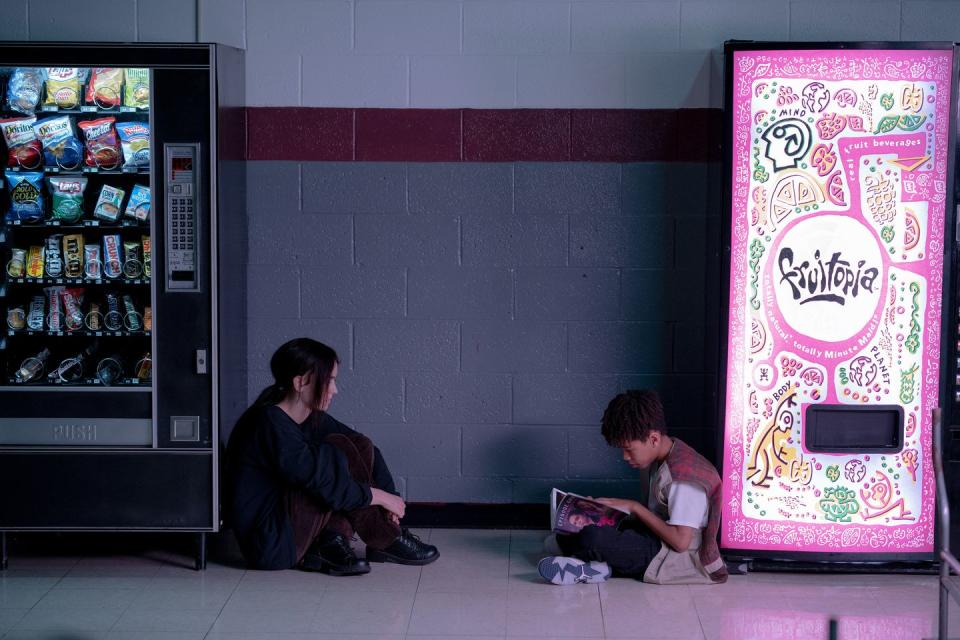
Smith links his own youthful obsessions to his current career path as an actor. “A lot of marginalized people growing up, we find ourselves in characters that aren’t actually us, but are us in some way. I was drawn to a lot of children’s horror like Goosebumps and Are You Afraid of the Dark? I think that spoke to my obsession with the supernatural, the world outside of our own, which maybe is emblematic of my own need to escape my reality.” He continues, “A lot of the reason I wanted to be an actor was because I loved playing pretend more than I loved being in reality. There’s definitely some weird interpretation of that, of my upbringing, just in addition to also living in a Black body in a very white environment. A lot of my identities weren’t welcome in the environment that I grew up in.”
The fixation of Lundy-Paine and Smith’s characters is The Pink Opaque, which follows teenagers Isabel (Helena Howard) and Tara (Snail Mail’s Lindsay Jordan) who meet at sleepaway camp and realize that they are psychically connected. Living on opposite sides of the county, the two realize that their connection comes with a duty to fight the evil Mr. Melancholy, the man on the moon, who is trying to distort reality. They must fight his henchmen while escaping the Midnight Realm—the prison he wants to trap them in. The perfectly ’90s premise is the type of show that would launch Geocities websites filled with Isabel and Tara fanfiction (à la Buffy and her fellow slayer Faith) and that’s exactly what Schoenbrun wanted from it. They joke that creating The Pink Opaque was essentially them just doing their own Buffy fan fiction, giving their 13-year-old self the gift of paying tribute to the show. When it came to directing Howard and Jordan for the show within the film, Schoenbrun had specific directions. “I remember talking to them ahead of time. And just being like, ‘I’m not going to be coy with you about this. You two are in sexual love.’ I’m going to say the thing that would’ve never actually been said on the set of this TV show, but it needs to ring loudly from that. It’s not supposed to be subtle. The queercoding is loudly coded.”
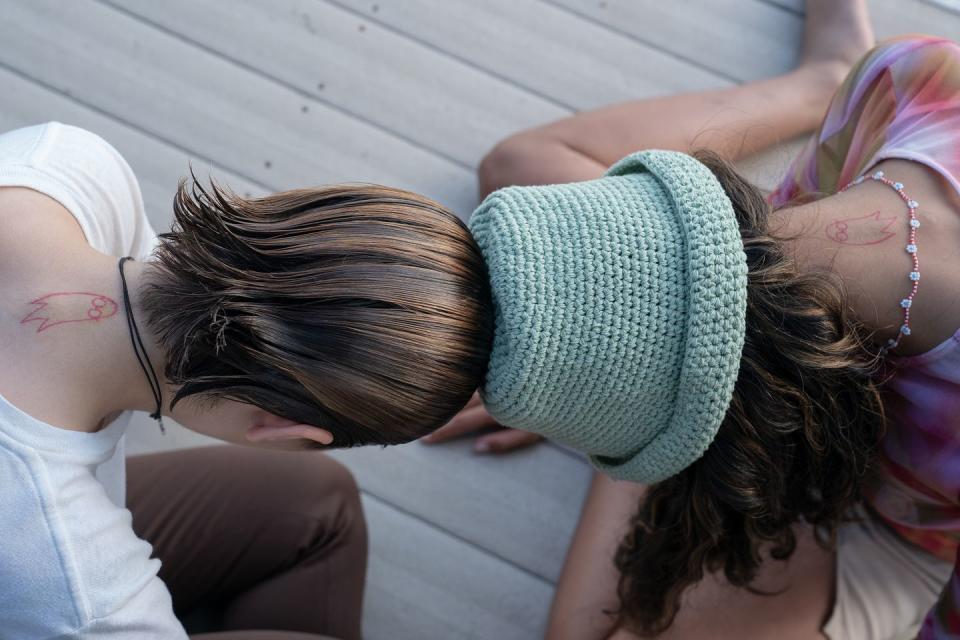
While many LGBTQ viewers have connected with the film, members of the transgender community recognize Schoenbrun telling the story of the “egg crack,” the moment when a person first realizes they are trans. Much of this is seen through Owen as he continues to become increasingly “hollow,” as Smith puts it, throughout the film as he hides from his truth. He says, “I was just in an interview with Jane where they talked about there’s a reason why transness is not more overt in the film because transness traditionally is represented as an external change. And obviously those representations are usually crafted by cis people, but artists often when they talk about transness, they’re trying to evoke an inner feeling. It’s such an inner change that happens. And this film, you don’t understand it logically; you feel it,” he says. “We’ve already experienced a lot of trans audiences immediately getting it, whereas other people who maybe don’t relate to that specifically are still feeling something under their skin. That’s the beauty of Jane’s art and the beauty of letting trans people tell their stories.”
A monologue given by Maddy late in the film also evokes a physical feeling and did for Lundy-Paine while they practiced the monologue a year before filming. Going into it, they knew that it would be a crux of the film and needed it to stick. Schoenbrun “had written the monologue in a moment of vulnerability and so it felt like it was one of the most raw moments,” Lundy-Paine says. “I think about it all the time now even after we stopped filming. The poetry of the film is with me through choices that I’ve been making since.” Schoenbrun knew that monologue would be the emotional crescendo of the film. The words came to them on a stroll in their Brooklyn neighborhood. “I remember this day when I was walking and then I had to go to Walgreens to pick up my gender pills so I could keep being a girl. I remember I was waiting in line at Walgreens scribbling down that monologue on a notepad file and an early version of it, but I think it did kind of come from feeling and just a lot of open space.”
Schoenbrun’s ability to portray vulnerability in such an honest way has connected an audience of trans people to their work. “Last night somebody came up to me…and very quietly was like, ‘That was my egg crack that just happened.’ It’s the idea that the work can be felt in this way. I give that person a hug and then don’t try to be their mother beyond the film itself—that’s what the trans girls I know who play that role for other trans girls call themselves.” Schoenbrun knows their art can help other people, “but the work is emotional and the work is personal and the work is trying to share experience with the person on the other end of it,” they say. “It’s almost like I create an idea of myself that can go out in the world and talk to you. I’m going to be hiding and trying to continue to have boundaries between my public life and my private life.”
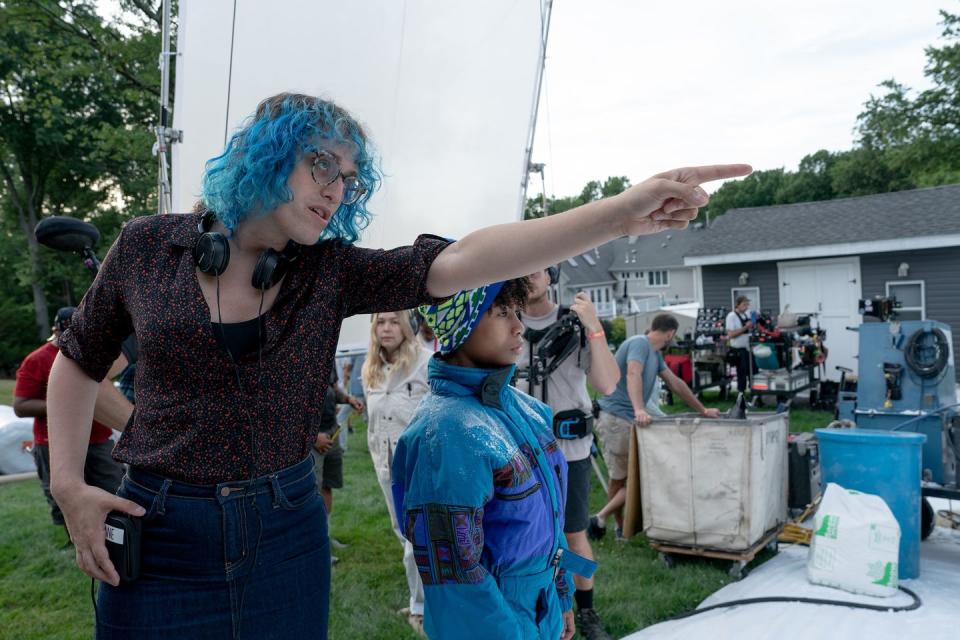
While TV Glow has opened up aspects of the film canon things behind the curtain are another story. Schoenbrun worked as best as they could do to curate a film that had queer people on both sides of the camera. It was an environment that both Lundy-Paine and Smith glowingly described. But from a labor perspective, Schoenbrun admits that they couldn’t get queer or trans people in certain authority positions they wanted, and there were “various battles that I tried to fight” behind the scenes.
That’s something that plays into the continued rarity of trans people telling their own stories. So while it might seem like a boom is happening with other current films from trans filmmakers like The People’s Joker and Stress Positions, Schoenbrun is rightfully wary of celebrating. “I’m stoked to see trans films and this whatever minor wave is hitting right now because for American independent films, [this] is not actual tangible long-term progress. Nothing makes my blood boil more than seeing people be like, ‘Which is the best of the trans films?’ We get to just celebrate any wins we can have and the scraps that are available right now to people coming from a trans experience.” They point out that “the way those stories are sort of ghettoized and made to exist in a very limiting framework that we can’t trust will be there next year” is one of the reasons why they “just don’t trust the system [with] to help us all grow as artists in the way that we deserve to. This tension that we’re talking about isn’t going away because whatever this first wave of new trans voices is ushering in is something that started with the tipping point seven to 10 years ago, and it’s a generational divide that is quite pronouncing both in terms of the younger generation’s relationship to gender and queerness and transness.”
So while there’s an appetite and quite likely a growing audience for more trans cinema—Schoenbrun is right to question the Hollywood structure itself. The people who are in power are generationally out of touch. But ultimately, Schoenbrun thinks that what’s needed goes beyond a shift in the industry. Until the sort of gaze and value system that I share with the trans community, which, by nature of who we are has to be radically different than the boomer coded capitalist hellscape that we’re trying to circumambulate; until there is a place where we can exist without feeling insane and burnt out and needing to retreat into our little spaces that we built for ourselves where we can feel like ourselves, I don’t know that this tension or this problem gets better.”
Those same types of questions also permeate TV Glow. While Schoenbrun’s clear affection for their teen media and the ways it can help LGBTQ people find themselves shines through, at the same time, there are no easy answers or neatly wrapped up endings for Owen and Maddy, especially when The Pink Opaque crops up again late in the film. How can something that exists in a capitalist system that scorns liberation and identity also feel like a saving grace? Schoenbrun can’t fully answer that right now, but they want to create a space for it.
“There’s also this conversation in the movie about how, especially when capitalism gets involved, which of course it always will, it makes [something you love] weird and almost sinister in a way,” they say. It explores “the idea that I put so much love into this TV show that was being made in...not the healthiest environment, that there were all of these forces, not least of which was to sell shit underneath that love. So far, so much of my work has been about a revisionist gaze on that kind of all-encompassing fandom. Revisionist because it’s questioning itself while it’s playing the hits.”
Schoenbrun hopes that that approach can help us better understand what’s at the core of these experiences: “the limitations and also the beauty of being deeply in love with a commercial product.”
You Might Also Like

